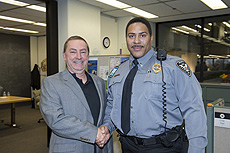Fermilab security officer returns lost diamond to St. Charles resident
 |
Fermilab Director Nigel Lockyer thanks Lieutenant Chris Jones, Fermilab security, for helping a neighbor who had lost a diamond in Kuhn Barn. Photo: Reidar Hahn
|
A diamond from a local resident's wedding ring, lost during an English country dance at Fermilab's Kuhn Barn, has been returned to her, thanks to the sharp eyes and sympathetic heart of Lieutenant Chris Jones, Fermilab security officer.
On Oct. 27, Wendy Hodowal of St. Charles was settling in at home after an evening of dancing at the barn when she realized that her wedding ring's principal diamond was missing. She immediately called Mady Newfield, dance organizer, who directed her to Fermilab Security.
"I was pretty distraught that evening and really didn't expect that the diamond would turn up," Hodowal said in a letter to Fermilab Director Nigel Lockyer. "It would be like finding a needle in a haystack!"
At 10:30 p.m. that night, she received a call from Lieutenant Jones with good news: He'd found the diamond. Although an initial sweep turned up nothing, Jones checked a second time, carefully inspecting the floor along the walls. He shined his flashlight underneath a rack of tables, and the diamond sparkled back at him.
"It felt pretty good to find it," Jones said. "I know how it feels to lose something like that."
Hodowal was grateful.
"I sincerely appreciate the fact that Chris Jones went above and beyond the ordinary expenditure of time, energy and effort to recover my lost diamond, return a call to me immediately so that I could rest easy that night, and then arrange for me to pick up the diamond the next day at my earliest convenience," Hodowal said.
"She would have missed it — it has sentimental value," Jones said. "It's the ring she got on her wedding day. Even if you replace it, it's not the same thing."
Director Lockyer met Jones after receiving Hodowal's letter to thank him for his service.
|